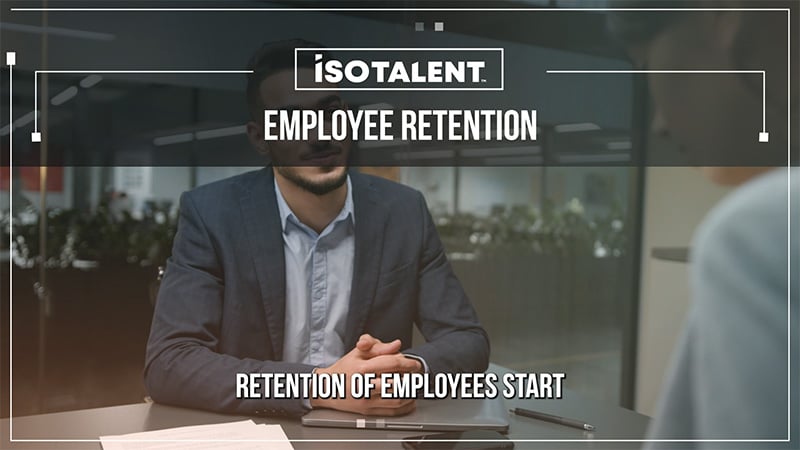What are HR Leadership Strategies?
HR Management Strategy and Insights for Today's Human Resources Leaders
Home > HR Management and Strategy
Whether you're an experienced HR professional seeking to sharpen your skills or a business leader looking to align HR initiatives with organizational goals, we’re here to provide valuable insights, practical tips, and actionable strategies to navigate the dynamic world of HR leadership and strategy. Explore the key components of HR leadership, understand the intricacies of HR strategy development, and discover how aligning your HR efforts can drive long-term success for your organization below.

HR Strategies for Employee Retention
What is HR Leadership?
HR leadership refers to the guidance and direction provided by Human Resources professionals who hold leadership positions within an organization. These leaders are responsible for overseeing HR functions, setting strategic HR goals, and ensuring that HR initiatives align with the organization's overall objectives. HR leaders play a crucial role in shaping the workplace culture, fostering employee engagement, and driving talent management strategies.
What is a Long Term HR Strategy?
A long term HR strategy is a carefully designed and executed plan that outlines an organization's approach to managing its human capital to achieve its broader business goals. It encompasses various aspects of HR, including recruitment, training and development, performance management, compensation and benefits, and employee engagement. A long term HR strategy aims to align the workforce with the organization's mission and vision, maximize employee contributions, and create a competitive advantage.
How Does HR Strategy Drive Organizational Success?
HR strategy aligns with an organization's long-term success by ensuring that its workforce is equipped with the right skills, motivation, and support to achieve strategic objectives. It focuses on talent acquisition, retention, and development, all of which are critical drivers of organizational growth. HR strategy also helps create a positive workplace culture that fosters innovation, employee satisfaction, and adaptability—factors vital for sustained success.
What Data Does an Organization Need to Make Informed HR Decisions?
To make informed HR decisions, organizations require a range of data, including:
- Workforce Demographics: Data on employee demographics, such as age, gender, and ethnicity, to assess diversity and inclusion efforts.
- Recruitment Metrics: Information on the effectiveness of recruitment channels, time-to-fill job vacancies, and cost-per-hire to optimize hiring strategies.
- Performance Metrics: Data on employee performance, including key performance indicators (KPIs) and goals, to evaluate productivity and contributions.
- Employee Engagement Data: Surveys, feedback, and sentiment analysis to gauge employee satisfaction, engagement levels, and areas for improvement.
- Retention Rates: Information on employee turnover rates and reasons for leaving to identify retention strategies.
- Compensation and Benefits Data: Details on employee compensation, benefits, and total rewards to ensure competitiveness in the job market.
- Training and Development Metrics: Records of employee training and development programs, skills assessments, and competency gaps to support talent growth.
- Employee Feedback: Regular feedback mechanisms, such as exit interviews and employee surveys, to capture employee opinions and concerns.
By collecting and analyzing these types of data, organizations can make data-driven decisions that enhance HR practices, optimize workforce management, and contribute to the overall success of the organization.
What Is Effective HR Leadership?
What are People Operations?
People Operations, often referred to as "People Ops," is an approach to managing and optimizing an organization's workforce that goes beyond traditional HR practices. It encompasses a more holistic and strategic view of employee management, focusing on the entire employee lifecycle. People Ops aims to create a positive employee experience and enhance productivity, engagement, and overall business success.
In-depth expertise for HR professionals involves understanding that People Ops involves data-driven decision-making, employee feedback loops, and a strong emphasis on culture and employee well-being. HR professionals in People Ops roles must be proficient in talent management, employee engagement, performance metrics, and use technology to streamline processes and gain insights.
People Ops professionals are responsible for creating an inclusive, supportive workplace where employees are empowered to reach their full potential. They play a critical role in aligning HR practices with the organization's strategic goals, fostering a culture of continuous improvement, and using data analytics to inform HR strategies.
What are HRIS systems?
HRIS (Human Resource Information System) systems are software solutions designed to streamline HR processes and manage HR-related data more efficiently. HRIS systems serve as a centralized database for storing and managing employee information, from recruitment and onboarding to payroll and performance management.
To provide in-depth expertise for HR professionals, it's crucial to understand the key functions of HRIS systems:
- Data Management: HRIS systems store and organize employee records, including personal information, job history, benefits enrollment, and training records. They ensure data accuracy and security.
- Automation: HRIS automates various HR tasks such as payroll processing, leave management, and compliance reporting, reducing manual workload and minimizing errors.
- Analytics: These systems provide HR professionals with valuable data and insights to make informed decisions, track key metrics, and assess workforce trends.
- Recruitment and Onboarding: HRIS systems often include applicant tracking systems (ATS) to streamline recruitment, from job posting to candidate selection and onboarding.
- Employee Self-Service: They offer self-service portals where employees can access their records, request time off, view pay stubs, and update personal information.
- Compliance: HRIS systems help ensure compliance with labor laws, tax regulations, and industry-specific requirements.
An HR professional's expertise in HRIS systems involves selecting the right system for the organization's needs, implementing it effectively, training staff, and using it to enhance HR efficiency, accuracy, and data-driven decision-making.
What Makes an Effective Talent Acquisition Strategy for HR Leadership?
An effective talent acquisition strategy is crucial for HR leadership to attract and retain top talent. HR leaders must consider several key components to develop a successful strategy:
- Alignment with Business Goals: HR leadership should align the talent acquisition strategy with the organization's overall strategic objectives. Understanding the company's growth plans and skill gaps is essential.
- Employer Branding: Building a strong employer brand helps attract top candidates. HR leaders should communicate the company's values, culture, and opportunities effectively to potential hires.
- Sourcing Channels: Identifying the most effective sourcing channels for candidates, which may include job boards, social media, employee referrals, and recruitment agencies, is crucial.
- Candidate Experience: Creating a positive candidate experience from the first interaction is vital. It involves clear communication, efficient processes, and respectful treatment.
- Data and Analytics: HR leaders should leverage data and analytics to track the effectiveness of their talent acquisition efforts. This includes analyzing time-to-fill, cost-per-hire, and quality of hires.
- Diversity and Inclusion: A strong talent acquisition strategy should prioritize diversity and inclusion, ensuring a diverse candidate pool and fostering an inclusive workplace.
- Continuous Improvement: HR leaders must regularly evaluate and refine their talent acquisition processes to adapt to changing market conditions and candidate preferences.
- Technology and Automation: Leveraging HRIS and ATS systems can streamline recruitment processes, enhance efficiency, and improve candidate tracking.
- Collaboration: Effective talent acquisition requires collaboration between HR, hiring managers, and other stakeholders. HR leaders should facilitate open communication and cooperation.
- Retention Strategies: HR leadership should work closely with other departments to develop strategies for retaining top talent once they're onboard.
In-depth expertise in talent acquisition involves staying updated on industry trends, understanding the competitive talent landscape, and being adaptable in response to changing hiring needs and challenges. An effective talent acquisition strategy not only attracts top talent but also contributes to the organization's long-term success.
What Are HR Leader Responsibilities?
What are the Fundamentals of HR Strategy and Leadership?
The fundamentals of HR strategy and leadership form the cornerstone of successful human resource management within organizations. In this dynamic and ever-evolving field, HR professionals play a pivotal role in shaping an organization's workforce, culture, and strategic direction and include a range of critical areas, including talent acquisition, employee development, diversity and inclusion, compliance, and leadership development.
A robust HR strategy not only aligns with an organization's broader goals but also guides the development and execution of initiatives that promote employee engagement, productivity, and overall organizational success. This discussion delves into the key principles and practices that underpin effective HR strategy and leadership, shedding light on the essential components that drive HR excellence…
Holistic Employee Well-Being: HR leaders should prioritize holistic employee well-being, including physical, mental, and emotional health. Leaders might overlook the profound impact of well-being on productivity, engagement, and retention. By providing resources and support for mental health, stress management, and work-life balance, organizations can foster a healthier, more motivated workforce.
Remote Work Transformation: The shift to remote work isn't just a temporary response to crises. It's a fundamental transformation that leaders should embrace strategically. They might underestimate the need for clear remote work policies, robust digital infrastructure, and ongoing support for remote employees. By optimizing remote work, organizations can tap into a global talent pool and improve work-life integration.
Employee Training and Development in the Digital Age
Data-Driven Decision-Making: Leaders often underutilize data in HR strategy. They may rely on intuition or tradition rather than harnessing the power of workforce analytics. By collecting and analyzing data on recruitment, engagement, turnover, and diversity, leaders can make more informed decisions that align with organizational goals.
Diversity and Inclusion (D&I): D&I initiatives should go beyond compliance. Leaders may underestimate the significance of creating a culture of inclusion and belonging. By fostering diverse perspectives and inclusivity, organizations can drive innovation and better serve diverse customer bases.
Aligning HR Metrics with Business Outcomes: HR metrics should directly correlate with business outcomes, but leaders often struggle to establish this link. Instead of focusing solely on HR-related metrics, such as turnover rates, HR leaders should tie their efforts to broader business objectives like revenue growth, customer satisfaction, or product innovation.
Continuous Learning and Development: HR leaders might take for granted the effectiveness of traditional training methods. Embracing modern, personalized, and technology-driven learning and development programs can boost skills and adaptability, helping employees thrive in a rapidly changing work environment.
Embracing Agile HR: Organizations need to adapt quickly, yet traditional HR processes can be slow and rigid. Leaders may overlook the benefits of adopting Agile HR principles, which involve iterative, collaborative, and responsive approaches to HR practices. Agile HR can enhance flexibility and responsiveness, enabling organizations to navigate change more effectively.
Employee Feedback and Listening: Leaders often assume they understand their employees' needs and concerns. However, they might underestimate the power of regularly seeking employee feedback and actively listening. Surveys, focus groups, and open forums can uncover insights that drive meaningful change and employee engagement.
Mastering the Art of Conflict Resolution
Leadership Development at All Levels: Leadership development isn't solely for top executives. Leaders should invest in developing leadership skills at all levels of the organization. By nurturing a leadership pipeline, organizations can ensure a continuous supply of capable leaders and maintain cultural alignment.
Human-Centric Technology: Technology should enhance, not replace, the human element in HR. Leaders may inadvertently overlook the importance of selecting and implementing HR technology that improves the employee experience rather than adding complexity. User-friendly, intuitive HR systems can streamline processes and boost adoption.
Top HR Leadership Principles You Should Know
Top 10 TED Talks on HR Leadership - Summarized

What Questions Should an HR Team Ask to Assess Strategy and Leadership?
These inquiries help you ask persistent, curious, and performance-driven questions of your people operations and recruitment:
- What is our organization's long-term vision, and how does HR strategy align with it?
- What are the key talent gaps and workforce trends we need to address in our HR strategy?
- How can we enhance employee engagement and retention through our HR leadership approach?
- What is the role of diversity and inclusion in our HR strategy, and how do we measure progress?
- Are our HR policies and practices compliant with current labor laws and regulations?
- What data and analytics are we using to make informed HR decisions?
- How do we ensure that our HR initiatives contribute to the organization's bottom-line results?
- What are the critical skills and competencies our workforce needs, and how are we developing them?
- How do we foster a culture of continuous learning and innovation within our HR team?
- What is our succession plan for key leadership positions in HR and the organization?
- What technology and tools can we leverage to streamline HR processes and improve the employee experience?
- How do we measure the effectiveness of our recruitment and onboarding processes?
- What strategies do we have in place to manage remote or distributed teams effectively?
- How do we handle employee well-being and mental health in our HR leadership approach?
- What steps are we taking to future-proof our HR strategy against emerging workplace trends and challenges?
Download these Questions for Quick Reference
Take the Next Step In HR Excellence
By fostering effective leadership, embracing strategic HR planning, and aligning human capital initiatives with the overarching mission of your organization, you can create a workplace that thrives, adapts, and drives sustainable success. Armed with the knowledge and insights gained from this guide, you are well-equipped to navigate the complexities of HR leadership and strategy, steering your organization toward a future defined by excellence, innovation, and optimal workforce management.


© 2025 IsoTalent, Inc. All rights reserved. IsoTalent Recruiting | 1 (877) 619 3486
2600 Executive Pkwy Suite 380, Lehi, UT 84043

